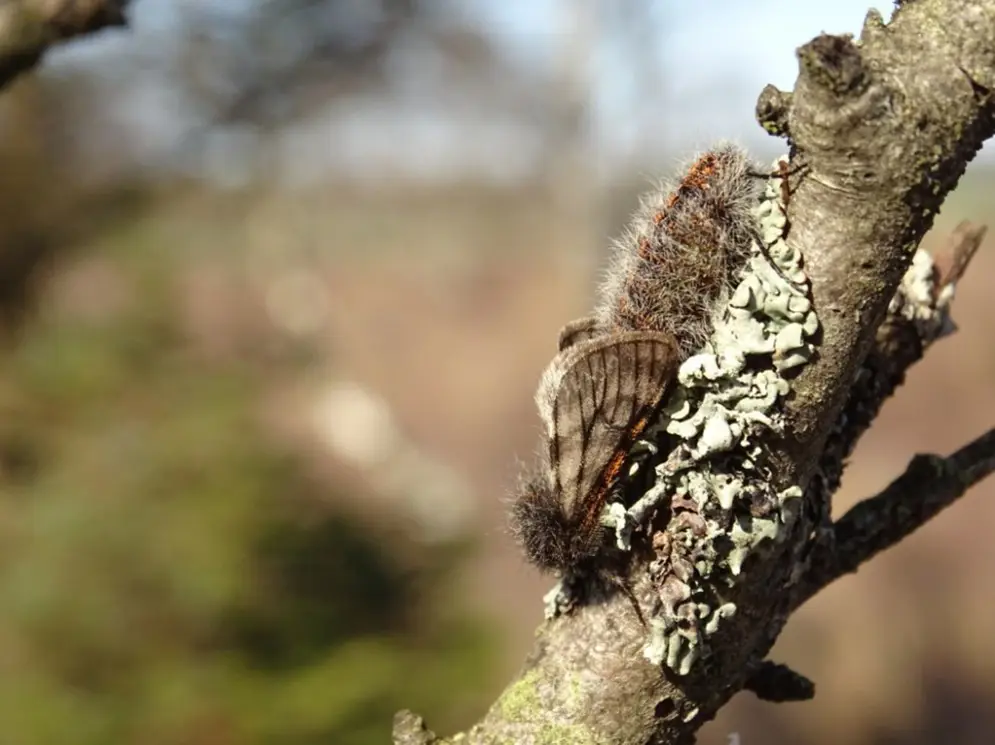Fence post fluff
If you go out to the more open areas of Scotland’s national forests and land, especially places with deep heather and old fence lines, you may see someone looking somewhat intently at the fence posts.
They are likely checking each post for resting moths or other invertebrate species, such as small dark yellow underwing found on a post on Loch Shaw last year. Despite their unnatural purpose, fence posts are widely used by a range of species closely associated with open moorland and bog habitats. This is because they mimic the stems of trees and tall vegetation often missing from these sites.

A female Rannoch Brindled Beauty on a fence post in Glen Prosen
One such moth we’ve been searching fence posts for is the Rannoch Brindled Beauty. Volunteers have recently recorded a population of these rare moths on one of our newer parcels of land just south of Cairngorms National Park. On the open landscape of Glen Prosen, old stock-fence posts are used by the flightless females and males. They have a strong preference for areas with abundant bog myrtle, on which the caterpillars feed, as well as heathers.
Rannoch Brindled Beauty is a nationally scarce species with only localised distribution across the Highlands, Speyside and central region of Scotland. It is a peatland and moorland-dwelling species, with the Flanders Moss area being the most southerly place they are found. As lepidopterists, those who study and record moths and butterflies, learn more about Rannoch Brindled Beauties new records are added, including recent records at Glen Prosen.
The female Rannoch Brindled Beauty resembles a blob of fluff: she is around 10-12 mm long, and easily spotted when sitting atop a fence post. She does technically have wings, but somewhere through evolution they have resulted in small vestigial wings.

A male Rannoch Brindled Beauty.
The males are fully-winged. They are grey-whitish in appearance with orange marks along the lower wing edge. The fluffy body is also evident, with a fuzzy ‘head’ sticking out above his wings. Someone recently described the male as looking like it’s wearing a vintage-style fur coat, which our staff agreed was a fitting analogy. Both male and female have a broken orange line along their back.
Since the females are ‘wingless’, they have limited mobility to disperse. This is where the fence posts come in. They climb to high points on their moors and bogs – fence posts and small Birch trees are ideal. A good lichen-covered fence post with lots of cracks is a female Rannoch Brindled Beauty’s favourite hang-out spot.
Here, they pump out their pheromones and wait for the males to come. Once they’ve done their thing, the female then lays eggs in the cracked post. A few weeks later, small caterpillars hatch, send out silk strands which catch the breeze, and they float off – hoping to land on their food plant Bog Myrtle. Although a high-risk strategy it seems to have done the job so far.

A mating pair of Rannoch Brindled Beauty on a tree branch.
This creative method of dispersal and survival depends on key habitat conditions and food supply, and the Rannoch Brindled Beauties serve as an indicator species for potential changes occurring on peat and moorland habitats. Factors like climate change and deer-overgrazing could have a dramatic effect on Rannoch Brindled Beauty’s and many other invertebrates.
At Glen Prosen, people and nature will be at the heart of our landscape-scale plans for the area, plans that will include an element of tree planting, peatland restoration and habitat restoration work.
The new local population at Glen Prosen will be surveyed in greater detail as plans for the site develop, to ensure their key habitat is protected and conditions for the enhancement of the species are incorporated into the sites overall objectives.
If you are out and about on the more open areas of the country, especially places with deep heather and old fence lines, you may want to take a peek at the fence posts just in case there’s a Rannoch Brindled Beauty or other species present. Any sightings in the national forests and land can be reported to one of our regional offices.
- Lichen survey at Whitelee forest
- Open habitat conservation
- Protecting rare species on west coast hazel